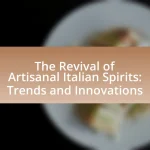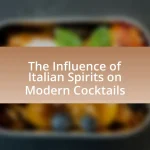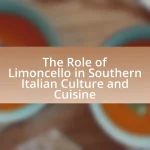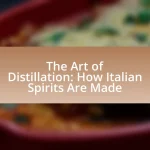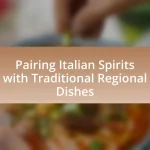The article focuses on the significance of pairing Italian cheeses with wine in a bar setting, emphasizing how these combinations enhance the tasting experience by complementing flavors and textures. It explores the influence of cheese flavor profiles on wine pairing, highlighting key characteristics of popular Italian cheeses such as Parmigiano-Reggiano, Gorgonzola, and Pecorino Romano. The article also discusses the importance of regional pairings, basic principles of cheese and wine pairing, and common mistakes to avoid. Additionally, it provides practical tips for presenting pairings effectively, enhancing customer experiences, and hosting creative pairing events.

What is the significance of pairing Italian cheeses with wine at your bar?
Pairing Italian cheeses with wine at your bar enhances the overall tasting experience by complementing flavors and textures. This significance lies in the traditional Italian practice of matching specific cheeses with regional wines, which creates a harmonious balance that elevates both the cheese and the wine. For instance, pairing a sharp Pecorino with a robust Chianti can highlight the cheese’s saltiness while softening the wine’s tannins, resulting in a more enjoyable palate experience. This practice is rooted in Italian culinary culture, where such pairings have been refined over centuries, making it a vital aspect of authentic Italian dining.
How does the flavor profile of Italian cheeses influence wine pairing?
The flavor profile of Italian cheeses significantly influences wine pairing by determining the compatibility of taste, texture, and aroma between the cheese and the wine. For example, the rich and creamy texture of cheeses like Gorgonzola pairs well with sweet wines such as Vin Santo, as the sweetness balances the cheese’s sharpness. Conversely, the nutty and savory flavors of Parmigiano-Reggiano complement dry red wines like Chianti, which enhances the cheese’s umami notes. This pairing principle is supported by the Italian tradition of matching local wines with regional cheeses, ensuring that the flavors enhance rather than overpower each other.
What are the key characteristics of popular Italian cheeses?
Popular Italian cheeses are characterized by their diverse textures, flavors, and aging processes. For instance, Parmigiano-Reggiano is known for its hard, granular texture and nutty flavor, resulting from a long aging period of at least 12 months. Mozzarella, on the other hand, is recognized for its soft, creamy texture and mild taste, typically made from water buffalo milk. Gorgonzola features a distinct blue veining and a strong, tangy flavor, which comes from the specific mold used during its production. Pecorino Romano is a hard cheese made from sheep’s milk, known for its salty and sharp flavor, often aged for at least five months. These characteristics not only define the cheeses themselves but also influence their pairing with wines, enhancing the overall tasting experience.
How do different textures of cheese affect wine choices?
Different textures of cheese significantly influence wine choices, as the mouthfeel and flavor intensity of the cheese can complement or contrast with the characteristics of the wine. For example, creamy cheeses like Brie pair well with sparkling wines, which enhance the richness, while hard cheeses such as Parmigiano-Reggiano are often matched with robust red wines that can stand up to their strong flavors. Research indicates that the fat content in cheese affects the perception of tannins in wine; higher fat cheeses soften tannins, making them more palatable with bold wines. Thus, understanding the texture of cheese is crucial for selecting the appropriate wine to enhance the overall tasting experience.
Why is it important to consider regional pairings?
Considering regional pairings is important because it enhances the authenticity and flavor profile of food and wine combinations. Italian cuisine, for example, has a rich tradition of pairing local cheeses with wines from the same region, which often share complementary characteristics due to similar terroirs. This practice is supported by the concept of “terroir,” where the environmental factors of a specific region influence the taste of both the cheese and the wine, leading to harmonious pairings that elevate the dining experience.
What regions in Italy produce the best cheeses for wine pairing?
The regions in Italy that produce the best cheeses for wine pairing are Lombardy, Piedmont, and Tuscany. Lombardy is renowned for its Gorgonzola, a blue cheese that complements robust red wines. Piedmont is famous for its Taleggio, which pairs well with Barbera wines. Tuscany offers Pecorino, a sheep’s milk cheese that enhances the flavors of Chianti. These cheeses are celebrated for their unique flavors and textures, making them ideal companions for various Italian wines.
How do local wines complement regional cheeses?
Local wines complement regional cheeses by enhancing the flavors and textures of both. The acidity and tannins in wines can balance the creaminess of cheeses, while the unique terroir of local wines often mirrors the characteristics of the regional cheeses, creating a harmonious pairing. For example, a sharp Pecorino cheese from Tuscany pairs well with a Chianti, as the wine’s acidity cuts through the richness of the cheese, while the wine’s earthy notes complement the cheese’s flavor profile. This synergy is supported by studies showing that regional pairings often result in a more enjoyable tasting experience due to the alignment of flavor compounds.
What are the basic principles of cheese and wine pairing?
The basic principles of cheese and wine pairing involve balancing flavors, textures, and intensities. Pairing complementary flavors enhances the tasting experience; for example, a creamy cheese like Brie pairs well with a fruity wine like Chardonnay. Additionally, contrasting flavors can create a pleasing balance; a sharp blue cheese can be offset by a sweet dessert wine like Sauternes. The texture of the cheese should also match the body of the wine; for instance, a rich, aged cheese pairs nicely with a full-bodied red wine. These principles are supported by the idea that both cheese and wine share similar flavor compounds, which can enhance or diminish each other’s characteristics when paired correctly.
How do acidity and sweetness play a role in pairing?
Acidity and sweetness are crucial in pairing because they create balance and enhance flavors. High acidity in wines, such as Chianti, complements rich, creamy cheeses like Brie by cutting through the fat, while sweetness in wines, like Moscato, can soften the sharpness of aged cheeses, such as Parmigiano-Reggiano. This interaction not only elevates the tasting experience but also aligns with the principle that contrasting flavors can harmonize, as supported by the concept of flavor pairing in culinary science.
What are the common mistakes to avoid when pairing?
Common mistakes to avoid when pairing Italian cheeses with wine include ignoring the flavor profiles of both the cheese and the wine, which can lead to mismatched tastes. For instance, pairing a strong, pungent cheese like Gorgonzola with a delicate wine can overwhelm the palate. Additionally, failing to consider the texture of the cheese and the body of the wine can result in an unbalanced experience; a creamy cheese pairs better with a full-bodied wine. Another mistake is not serving the cheese at the appropriate temperature, as this can affect the flavor release. Lastly, overlooking regional pairings can lead to missed opportunities for complementary flavors, as certain wines and cheeses from the same region often enhance each other.
How can you enhance the pairing experience for your customers?
To enhance the pairing experience for your customers, provide curated pairing suggestions that highlight the unique flavors of Italian cheeses and wines. This can be achieved by training staff on flavor profiles and offering tasting flights that combine specific cheeses with complementary wines, allowing customers to explore and appreciate the nuances of each pairing. Research indicates that guided tastings can increase customer satisfaction and engagement, as evidenced by a study published in the Journal of Wine Research, which found that informed pairings enhance the overall tasting experience.
What tools and resources can assist in pairing Italian cheeses with wine?
Tools and resources that assist in pairing Italian cheeses with wine include pairing guides, mobile applications, and expert recommendations. Pairing guides, such as “The Wine Bible” by Karen MacNeil, provide detailed insights into flavor profiles and complementary pairings. Mobile applications like Vivino and Wine-Searcher allow users to scan labels and receive pairing suggestions based on user reviews and expert opinions. Additionally, consulting sommeliers or attending wine and cheese tasting events can offer personalized advice and enhance the pairing experience. These resources are valuable for achieving successful pairings that enhance the flavors of both the cheese and the wine.

What specific Italian cheeses should you consider for your bar?
Consider including Parmigiano-Reggiano, Gorgonzola, Pecorino Romano, and Mozzarella di Bufala for your bar. Parmigiano-Reggiano, known as the “King of Cheeses,” has a rich, nutty flavor that pairs well with full-bodied red wines. Gorgonzola, a blue cheese, offers a creamy texture and sharp taste, complementing sweet dessert wines. Pecorino Romano, a hard sheep’s milk cheese, provides a salty profile that matches well with white wines. Mozzarella di Bufala, with its fresh and milky flavor, is ideal for pairing with light, crisp wines. These cheeses not only enhance the wine experience but also represent the diversity of Italian cheese-making traditions.
What are the most popular Italian cheeses for wine pairing?
The most popular Italian cheeses for wine pairing include Parmigiano-Reggiano, Gorgonzola, Pecorino Romano, and Mozzarella di Bufala. Parmigiano-Reggiano, known for its nutty and savory flavor, pairs well with full-bodied red wines like Chianti. Gorgonzola, a blue cheese, complements sweet wines such as Vin Santo due to its creamy texture and sharpness. Pecorino Romano, a salty sheep’s milk cheese, is often enjoyed with white wines like Vermentino. Mozzarella di Bufala, with its fresh and mild taste, pairs nicely with light white wines like Pinot Grigio. These pairings are widely recognized in Italian culinary traditions, enhancing both the cheese and wine experience.
How does Parmigiano-Reggiano pair with different wines?
Parmigiano-Reggiano pairs well with a variety of wines, enhancing the flavors of both the cheese and the wine. The cheese’s nutty and savory profile complements white wines like Sauvignon Blanc and Chardonnay, which offer acidity that balances the richness of the cheese. Additionally, red wines such as Chianti and Barolo, with their tannins and fruitiness, create a harmonious contrast to the cheese’s saltiness. Studies indicate that the umami characteristics of Parmigiano-Reggiano can elevate the tasting experience when paired with these wines, making them a popular choice in culinary settings.
What wine complements Gorgonzola best?
The wine that complements Gorgonzola best is a sweet dessert wine, particularly a Sauternes or a late-harvest Riesling. These wines balance the strong, pungent flavors of Gorgonzola with their sweetness, creating a harmonious pairing. The sweetness of Sauternes, for example, has been noted for its ability to enhance the creamy texture and sharpness of the cheese, making it a classic choice in wine and cheese pairings.
What lesser-known Italian cheeses can surprise your customers?
Lesser-known Italian cheeses that can surprise customers include Casu Marzu, a traditional Sardinian cheese known for its live insect larvae, and Stracchino, a creamy cheese from Lombardy that pairs well with fruity wines. Casu Marzu’s unique texture and flavor profile, derived from the fermentation process involving larvae, offers an adventurous tasting experience. Stracchino, with its mild and buttery taste, complements wines like Pinot Grigio or Prosecco, enhancing the overall pairing experience. These cheeses not only provide distinct flavors but also introduce customers to the rich diversity of Italian cheese-making traditions.
How does Pecorino Romano enhance wine experiences?
Pecorino Romano enhances wine experiences by providing a robust, salty flavor that complements various wines, particularly whites and light reds. The cheese’s firm texture and sharpness balance the acidity and fruitiness of wines, creating a harmonious pairing. For instance, Pecorino Romano pairs well with Sauvignon Blanc, as the cheese’s saltiness accentuates the wine’s crispness, while its rich umami notes enhance the overall tasting experience. This synergy between Pecorino Romano and wine is supported by traditional Italian culinary practices, which emphasize the importance of balancing flavors in food and wine pairings.
What unique pairings can be created with Taleggio?
Taleggio pairs uniquely with fruits such as figs and pears, as well as with cured meats like prosciutto and salami. The creamy texture and mild flavor of Taleggio complement the sweetness of figs and pears, enhancing the overall tasting experience. Additionally, the saltiness of cured meats contrasts well with the cheese’s richness, creating a balanced palate. These pairings are supported by culinary practices that highlight the cheese’s versatility in Italian cuisine, where it is often enjoyed with both sweet and savory accompaniments.

How can you effectively present cheese and wine pairings at your bar?
To effectively present cheese and wine pairings at your bar, create a visually appealing display that highlights the selected cheeses alongside their complementary wines. This can be achieved by using attractive serving boards or platters that showcase the textures and colors of the cheeses, while also labeling each pairing clearly. Research indicates that visual presentation significantly enhances customer experience and decision-making, as noted in a study published in the Journal of Sensory Studies, which found that appealing visuals can increase perceived value and enjoyment of food and drink pairings. Additionally, offering tasting notes or pairing suggestions can educate patrons about the flavor profiles and enhance their appreciation for the combinations, further improving their overall experience.
What are the best serving methods for cheese and wine pairings?
The best serving methods for cheese and wine pairings include serving cheese at room temperature and using appropriate glassware for the wine. Cheese should be removed from refrigeration about 30 to 60 minutes before serving to enhance its flavor and aroma, as cold temperatures can mute these qualities. Additionally, using specific glassware, such as a tulip-shaped glass for aromatic wines, allows for better appreciation of the wine’s bouquet. This method is supported by the fact that temperature and glass shape significantly influence the sensory experience of both cheese and wine, enhancing the overall pairing experience.
How can you create a visually appealing cheese and wine display?
To create a visually appealing cheese and wine display, arrange a variety of cheeses and wines in an organized yet artistic manner. Use a wooden or slate board as a base to enhance the rustic aesthetic, and select cheeses with different textures and colors, such as creamy Brie, sharp Parmigiano-Reggiano, and tangy Gorgonzola. Pair these cheeses with complementary wines, like a crisp Pinot Grigio for the Brie and a robust Chianti for the Parmigiano-Reggiano. Incorporate garnishes such as fresh herbs, fruits, and nuts to add color and texture, making the display more inviting. Research indicates that visually appealing food presentations can enhance the dining experience, as supported by studies in food aesthetics and consumer behavior.
What information should you provide to customers about pairings?
Customers should be informed about the specific flavor profiles and characteristics of both the Italian cheeses and the wines to ensure optimal pairings. For example, a creamy Gorgonzola pairs well with a sweet dessert wine like Vin Santo, as the sweetness balances the cheese’s sharpness. Additionally, customers should be educated on the general principles of pairing, such as matching the intensity of flavors and considering complementary or contrasting tastes. Providing this information enhances the dining experience and encourages informed choices, ultimately leading to customer satisfaction.
What tips can help you create memorable pairing experiences?
To create memorable pairing experiences, focus on complementary flavors and textures between Italian cheeses and wines. For instance, pairing a creamy Gorgonzola with a sweet dessert wine like Vin Santo enhances the richness of the cheese while balancing its sharpness. Additionally, consider the regional origins of both the cheese and wine; for example, pairing Pecorino Romano from Lazio with a robust Chianti from Tuscany reflects traditional Italian culinary practices. This approach not only elevates the tasting experience but also educates patrons about the cultural significance of the pairings, making the experience more engaging and memorable.
How can you encourage customer feedback on pairings?
To encourage customer feedback on pairings, implement a structured feedback system that includes surveys and direct interactions. Surveys can be distributed after customers experience cheese and wine pairings, asking specific questions about their preferences and satisfaction levels. Direct interactions, such as staff asking for feedback during service, can also foster a conversational atmosphere where customers feel valued. Research indicates that businesses that actively seek customer input can improve their offerings by up to 20%, demonstrating the effectiveness of soliciting feedback in enhancing customer experience and product quality.
What are some creative pairing events you can host at your bar?
Host a wine and cheese pairing event featuring Italian cheeses and regional wines. This event can include tastings of specific pairings, such as Parmigiano-Reggiano with Chianti or Gorgonzola with a sweet dessert wine like Vin Santo. Research shows that pairing cheese with wine enhances the tasting experience, as the flavors complement each other, making it an engaging and educational experience for attendees.

